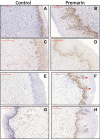The surgical effect on overactive bladder symptoms in women with pelvic organ prolapse
- PMID: 34642384
- PMCID: PMC8511333
- DOI: 10.1038/s41598-021-99537-w
The surgical effect on overactive bladder symptoms in women with pelvic organ prolapse
Abstract
This study aimed to explore the effect of pelvic reconstruction surgery on the relation of pelvic organ prolapse (POP) and overactive bladder (OAB) and the impact of preoperative vaginal oestrogen supplement on vaginal tissue. A total of 100 postmenopausal women with symptomatic POP who underwent pelvic reconstruction surgery (laparoscopic sacrocolpopexy or transvaginal mesh) were enrolled in this study. Preoperative vaginal oestrogen was prescribed in 28 cases. The evaluation tools consisted of POP-Q, urodynamic study, Overactive Bladder Symptom Score (OABSS), and urinary NGF. Vaginal maturation index and vaginal specimens for hormone receptors study were investigated during operation to evaluate the effect of topical oestrogen. Follow-up assessments were performed at 1, 3, and 6 months after surgery. Preoperatively, 58 (58%) were POP with OAB. After reconstruction surgery, the OABSS decreased significantly (6.87 ± 0.85 vs 3.77 ± 0.61, p < 0.001) at postoperative 6 months in the group. Remarkable increasing trends of urinary NGF levels are noted till 3 months postoperatively, then decreasing to the baseline level at 6 months postoperative follow-up. Remarkable decrease of mRNA of the androgen receptor and significant higher expression of progesterone receptor (PR) were noted after use of the vaginal oestrogen cream. The severity of OAB in the POP women shows moderate degree according to OABSS. Pelvic reconstruction surgery can significantly improve the OAB symptoms. The surgery induced inflammation effect lasts for about 6 months. Short-term preoperative supplement of topical oestrogen brings alterations of the vaginal epithelium.
© 2021. The Author(s).
Conflict of interest statement
The authors declare no competing interests.
Figures






Comment in
-
Geriatrics.J Urol. 2022 Jul;208(1):189-191. doi: 10.1097/JU.0000000000002725. Epub 2022 Apr 21. J Urol. 2022. PMID: 35443797 No abstract available.
References
-
- Drake MJ. Fundamentals of terminology in lower urinary tract function. Neurourol. Urodyn. 2018;37:S13–S19. - PubMed
Publication types
MeSH terms
Substances
LinkOut - more resources
Full Text Sources
Medical
Research Materials

